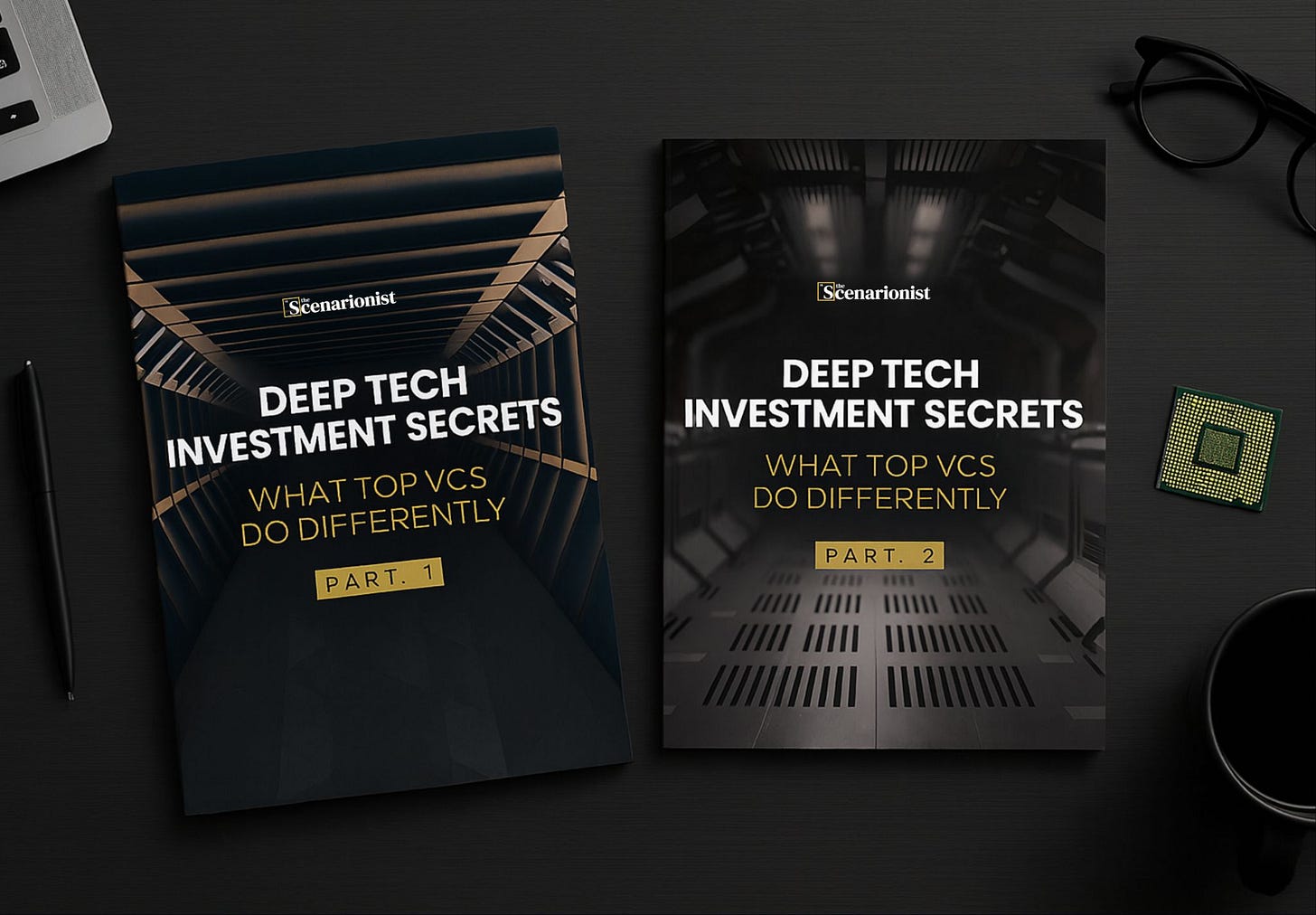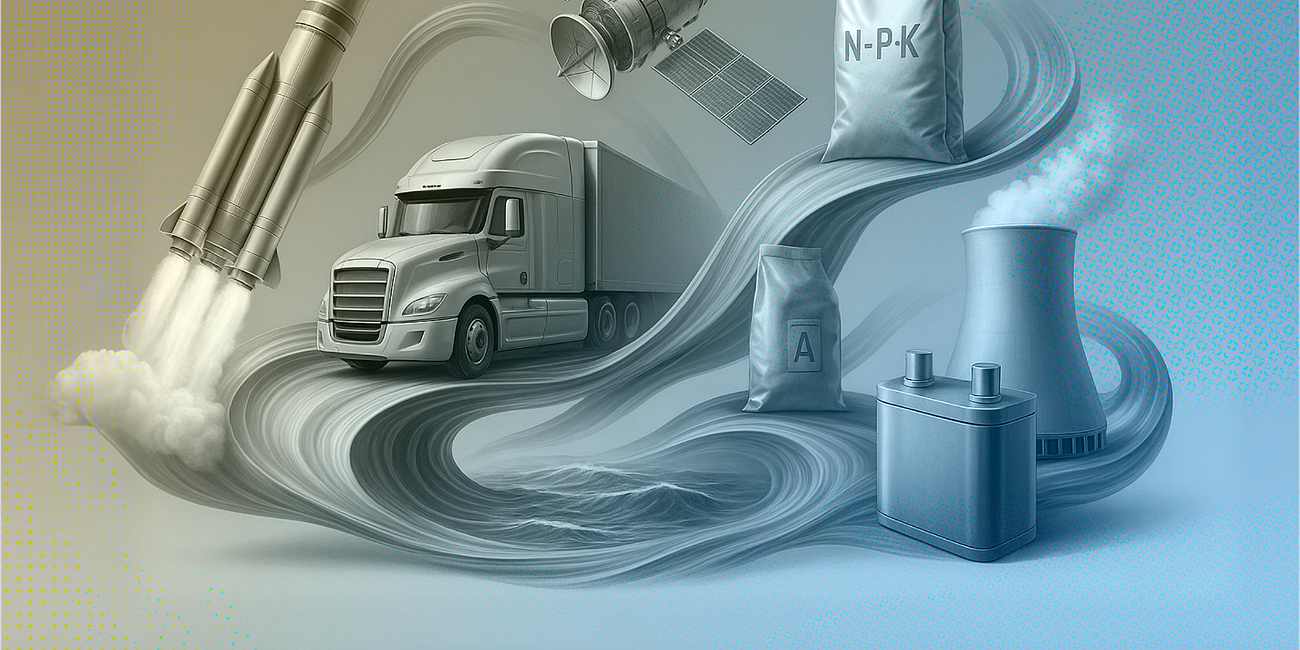Welcome to the 87th edition of Deep Tech Catalyst, the channel from The Scenarionist where science meets venture!
If you’ve been tracking the convergence of automation, robotics, and agriculture—but aren’t sure how these innovations become fundable companies—this episode is your field guide.
Today, we’re thrilled to welcome Ana Ward, Venture Capitalist at Yanmar Ventures!
Together, we explore what it takes to build investable companies at the frontier of agriculture and automation—from go-to-market strategy and pricing models to early pilots, distribution moats, and global scale-up.
In this edition, we explore:
How Robotics-as-a-Service is reshaping hardware economics for farmers and startups
Why modular systems, not full replacements, win early adoption
How to price early pilots, manage risk, and build trust with field partners
What separates a functional prototype from a scalable agtech business
Why regional validation is the launchpad for global market capture
Whether you’re a founder building in automation, an investor assessing AgTech opportunities, or a scientist exploring commercial pathways, this conversation offers a clear, grounded look at what it takes to go from pilot to platform—at the frontier of agricultural innovation.
Let’s dig in! 🚜
✨ For more, see Membership | Deep Tech Briefing | Insights | VC Guides
BEYOND THE CONVERSATION — STRATEGIC INSIGHTS FROM THE EPISODE
The New Frontier of AgTech
Across the agricultural landscape, the pace of technological innovation is accelerating. Automation is no longer a distant vision—it is now central to how farms operate, compete, and scale.
From the rise of autonomous tractors to the deployment of sensor-integrated platforms, the transformation is being driven by Deep Tech advances that address pressing pain points: labor shortages, operational inefficiencies, and the need for scalable precision.
Robotics, Drones, and AI
Autonomous tractors represent a particularly exciting development. Whether semi- or fully-autonomous, these machines are increasingly capable of performing core farming tasks like spraying, seeding, and planting, all while integrating a wide range of advanced technologies.
LiDAR systems, machine vision, and other sensors now work in tandem to enable reliable navigation, obstacle detection, and task execution. These tractors are evolving into sophisticated platforms that bundle multiple layers of innovation into a single operational unit.
Drones are also gaining momentum, especially when deployed in coordinated fleets. Their potential for high-efficiency pesticide or fertilizer application is only beginning to be realized. These fleets are redefining what scalability looks like in agriculture—offering flexibility, data capture, and field coverage that manual methods simply cannot match.
Harvesting robotics is another fast-moving frontier. The challenge of picking fruit—a task that requires remarkable dexterity and sensory input—is being met by machines that can identify ripeness, navigate complex crop environments, and handle delicate produce. Just a few years ago, this level of performance seemed out of reach. Now, it’s commercially viable.
The same is true for post-harvest technologies, like automated produce grading. These systems bring consistency, speed, and objectivity to a process that has long depended on manual labor.
Meanwhile, software augmented by artificial intelligence is taking on a more central role in decision-making. When integrated with sensors across the farm, AI-powered platforms can generate crop care recommendations, offer real-time analytics, and support precision agriculture at scale. The potential is particularly strong when these systems are part of a broader technology stack—amplifying their impact through interoperability.
Even in the specialized domain of weed control, autonomous solutions are gaining traction. These systems use diverse modalities—including lasers, electrical pulses, and mechanical implements—to target weeds with high accuracy and minimal disruption to crops. They embody the convergence of deep tech and agricultural pragmatism: solving real-world problems with cutting-edge tools.
Designing Business Models That Work in the Field
Avoiding Upfront Capital Barriers
In agricultural technology, even the most advanced product can fail if the business model doesn’t work for the customer. Farmers operate on tight margins, and their risk tolerance—especially when it comes to unproven tools—is understandably low.
That’s why one of the first principles in designing a business model for agtech is to avoid structures that demand significant upfront capital.
Requiring a farmer to purchase an entirely new system or fleet of equipment before realizing any benefit is a recipe for slow adoption. Instead, successful companies are designing offerings that minimize initial cost and align value capture with real-world outcomes. This approach reduces friction at the point of sale and enables a more pragmatic path to commercialization.
Modular Systems and Service-Based Pricing
Modularity is another key to early adoption. When farmers can start with a single component—a small add-on or demo unit—they gain the ability to test the product within their existing workflow.
If it proves valuable, they can scale up from there. This stackable approach to technology deployment not only reduces perceived risk but also gives companies a chance to demonstrate ROI incrementally.
Robotics-as-a-Service (RaaS)
Robotics-as-a-Service (RaaS) models are particularly compelling in this regard. By charging per acre, per hour, or per yield, startups can offer access to advanced robotics without the need for farmers to buy and maintain expensive hardware. This model also allows startups to generate recurring revenue, creating stronger business fundamentals from the outset.
Retrofits offer another promising path. By converting existing tractors or machines into semi-autonomous systems, startups can deliver a high-impact upgrade without requiring full equipment replacement. This approach is far more practical for many farmers and lowers the bar for trying something new.
In some cases, companies are developing modular software “brains” that can be integrated into third-party hardware. Licensing this software to original equipment manufacturers (OEMs) becomes a way to scale without needing to build entire machines from scratch.
Balancing Hardware and Software Plays
When hardware and software are combined—such as in sensor-enabled platforms for soil monitoring or crop diagnostics—hybrid business models come into play. One viable approach is to subsidize the cost of hardware or provide it free of charge, then monetize through the software layer. This strategy makes sense when the long-term value lies in recurring data subscriptions, analytics, or decision-support tools.
For software-only solutions, a freemium model can be powerful. Offering a basic platform for free helps build a broad user base, which is useful not only for scaling adoption but also for data aggregation. From there, companies can upsell premium features—such as advanced crop diagnostics, remote sensing integrations, or AI-driven recommendations.
In all cases, the business model needs to reflect the realities of the customer’s world. The most effective agtech startups are those that combine cutting-edge innovation with grounded economic logic—providing value in ways that are easy to access, prove, and scale.
DISCOVER OUR NEW SERIES…
What separates the deep tech startups that actually raise capital and scale—from the ones that never make it past the pilot phase?
We’ve done the heavy lifting: 80+ investor conversations, deep analysis, and a sharp editorial filter. The result?
A two-part premium series that reveals strategic patterns used by leading deep tech investors to get better deals, faster access, and lower downstream risk.
It captures how experienced backers turn deep tech’s inherent complexity into a strategic edge: from identifying transformative “10x” founders to engineering exit pathways that maximize long-term value.
Every section comes with practical checklists and field-tested insights.
👉 Unlock the full series — Start your premium access now
Building Trust Through Early Adopters
Farmers as Innovation Partners
In agtech, early-stage field testing isn’t just about proving functionality—it’s about building trust. Farmers are not passive users; they are essential partners in innovation. Their operations are complex, seasonal, and often unpredictable, which means startups must treat them not just as pilot customers, but as co-developers in the product journey.
During initial demos and pilots, being physically present on the farm is crucial. Troubleshooting in real time, listening closely to farmer feedback, and showing a clear commitment to improvement help lay the foundation for a long-term relationship. When a system doesn’t work as intended—which is often the case in the first iterations—it’s the founder’s responsiveness and transparency that determine whether the farmer remains engaged.
Positioning the farmer as a contributor to innovation changes the dynamic. They’re no longer just testing a product; they’re helping shape it. That sense of shared purpose can be a powerful asset, especially in a conservative industry where word-of-mouth and reputation still carry enormous weight.
Managing Expectations, Iteration, and ROI
Open communication is essential from the beginning. Startups should clearly state what stage the product is in, what it can realistically achieve now, and how it’s expected to evolve. Managing expectations doesn’t mean downplaying ambition—it means being honest about where things stand, and what success will look like across seasons.
At the same time, return on investment (ROI) must remain the north star.
Pilots should be structured in a way that allows both parties to assess impact—ideally through seasonal ROI reports or post-harvest evaluations. If the product can demonstrate clear value after one or two seasons, the path to broader adoption becomes far more straightforward.
But things can and do go wrong. That’s why it’s important to plan for failure modes in advance. Offering money-back guarantees or shared-risk pricing models—where the farmer only pays if certain performance thresholds are met—can help mitigate downside and keep both parties aligned through the development cycle.
Pricing Pilots with a Strategic Mindset
Pricing during the pilot phase is a sensitive balance. On one hand, startups want to encourage adoption by minimizing financial risk for the farmer. On the other, charging a nominal fee—even during an early trial—can send a strong signal of value and help cover operational costs.
There’s no universal rule, but maturity matters.
From an investor’s perspective, having a customer willing to pay—even a reduced amount—to test new technology is a clear sign of commercial traction. It signals real demand, not just interest.
The price point doesn’t need to reflect the eventual full-cost deployment. Instead, it can be designed as a ramp—starting low, then scaling as the product becomes more robust and the value delivered becomes more predictable. The key is to demonstrate that the customer is not only engaged but sees enough promise to put real money on the table.
Engineering for Growth
The Role of Pricing Strategy in Hardware Scalability
Scaling hardware in any sector is challenging—but in AgTech, it comes with particular constraints.
The economics must serve 2 masters: the farmer, who needs a reasonable payback period, and the company, which must maintain enough margin to fund manufacturing, support, and future growth. Striking that balance starts with smart pricing.
A solution that delivers ROI to the farmer within two seasons is a strong foundation.
But hitting that target means pricing must be carefully calibrated—not so low that the business becomes unsustainable, but not so high that adoption stalls.
For hardware in particular, failing to factor in the full costs of scaling—manufacturing, distribution, service—can result in thin margins and stalled growth.
Companies that scale well tend to build pricing models that reward performance and encourage usage. Whether that means usage-based pricing, leasing arrangements, or service contracts, the goal is to create recurring revenue without placing heavy financial burdens upfront. The model must also allow for growth over time—both in geographic reach and product capabilities.
What Not to Do When Scaling Deep Tech
One of the most common mistakes is underestimating operational complexity. A product that works in one field doesn’t automatically scale to dozens of regions or crop types. Variability in soil, climate, regulation, and farmer expectations can make expansion far more difficult than anticipated.
That’s why successful companies build modular systems—technologies that can adapt, integrate, or evolve without starting from scratch every time.
Another pitfall is ignoring cost structure in the name of rapid growth.
In the rush to gain early traction, some startups over-discount or offer too much support without a plan to reduce those costs later. That kind of model doesn’t scale, and investors know it.
Companies must also avoid designing for a use case so narrow that it limits future applicability. If the system solves only one isolated problem without a pathway to broader impact, scalability will always be constrained. The product must be extensible, ideally able to tackle multiple interrelated challenges as it matures.
Designing for Return on Investment and Repeatability
A scalable agtech business is one that understands its path to repeatable sales. That repeatability hinges on economics, performance, and deployment friction. If each new customer requires a bespoke setup or heavy technical support, scale becomes labor-intensive and costly. If, instead, the system is plug-and-play—or even better, driven by the customer’s own usage and learning—growth becomes far more capital efficient.
This is also where business model and product design converge. Modularity, data-driven insights, and outcomes-based pricing aren’t just good for adoption—they’re what make scalability viable. The most successful companies engineer both their product and their go-to-market strategy with repeatability in mind.
Scaling is not about building a slightly better prototype. It’s about laying the foundation for long-term commercial deployment—at a price point that sustains the company, delivers value to the customer, and unlocks future investment.
Strategy and Positioning
Strategic Distribution Channels in Fragmented Markets
In the fragmented world of agriculture, selling directly to individual farmers is rarely efficient. The customer base is diverse, geographically spread, and varies widely in needs and resources. For a startup aiming to scale, this makes building strong distribution channels essential—not just as a sales tactic, but as a strategic moat.
The ability to access customers through trusted intermediaries, cooperatives, OEMs, or regional partners can dramatically reduce time-to-market. It also signals maturity. Investors pay close attention to how a company plans to reach its market—and whether that plan is built for repeatable success. Establishing these partnerships early not only supports growth but creates defensible access that competitors may struggle to replicate.
Moats are not limited to product IP. In many cases, the distribution strategy is what creates long-term value and exit potential.
Proprietary Data
Another often underutilized asset is proprietary data. In agtech, where the value of insight can be as great as the value of hardware, collecting and owning meaningful datasets is a competitive advantage. This includes everything from soil and yield data to behavioral usage patterns and operational benchmarks.
Proprietary data becomes especially powerful when combined with a systems-level understanding of the farmer’s challenges. Solving just one problem—say, weed control—can be helpful. But solving a high-stakes, recurring, and interconnected set of problems—like maximizing yield while managing pest, disease, and nutrient variables—makes the solution indispensable.
This kind of framing elevates the company’s value proposition. It moves the product from being a useful tool to a strategic platform. And it opens the door to adjacent markets, higher-value integrations, and long-term customer lock-in.
Storytelling and Positioning for Exit
Within agtech, branding and storytelling are often overlooked. But when it comes to attracting crossover investors, climate-aligned capital, or later-stage funding, positioning matters.
Startups that clearly articulate how their solution fits into broader macro trends—like climate resilience, automation, or food security—are better able to command attention beyond the ag vertical. This positioning can also strengthen exit potential. A well-branded company with a credible story is more likely to be seen as a strategic acquisition or a partner in future ecosystem development.
Storytelling also matters.
Farmers want to know not only what a product does, but why it matters. If a startup can articulate how its innovation supports sustainability, cost-efficiency, and long-term viability, it stands a better chance of being remembered—and chosen.
Moats are built in many ways: through technology, yes—but also through distribution, data, and narrative. The companies that scale are those that invest in all of them.
Regional Focus, Global Expansion
For early-stage agtech startups, it’s tempting to pursue broad applicability from the beginning. But in reality, the most successful companies start narrow—focusing on a specific crop in a single geographic region. This targeted approach allows for more controlled testing, clearer economic validation, and deeper user feedback during the critical early phases of development.
Localizing the initial deployment also makes it easier to align with regional agronomic practices, regulatory frameworks, and customer behaviors.
The ability to adapt to these localized conditions is key to proving both technical viability and market fit. Once that foundation is solid, startups can begin the process of generalization—extending to other crops, regions, or farming systems.
This model of deep validation followed by systematic expansion is not only efficient—it also creates momentum. Success in one crop-region combination gives credibility when approaching new markets and can serve as a template for scale.
Generalizing and Expanding Market by Market
Scaling globally isn’t about launching everywhere at once. It’s about sequencing intelligently. A company might validate a harvesting robot in a specific fruit crop, meet a set revenue target, and then expand to a similar crop with shared characteristics.
From there, expansion continues—but always with an eye toward minimizing reinvention and maximizing the reusability of technology, data, and customer insights.
Generalizability is the end goal, but it must be earned. It requires not only technical flexibility but also a growing network of partners who can support deployment in new regions. Whether through distributor relationships, co-development partnerships, or joint ventures, building local infrastructure is what turns a global strategy into an operational reality.
Why Are US VCs Writing AI Term Sheets Far From Sand Hill Road? | Deep Tech Briefing #74
Weekly Intelligence on Deep Tech Startup and Venture Capital. Every Sunday, we curate and analyze the most relevant startup advancements, VC trends, and industry shifts you need to know-if you want to lead!













